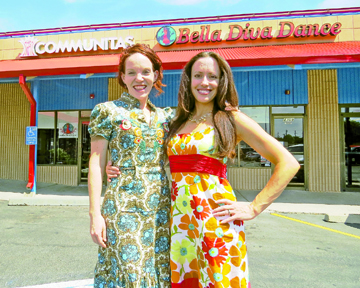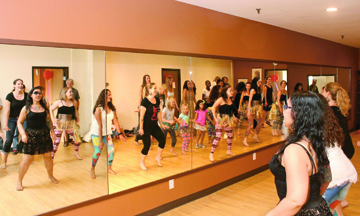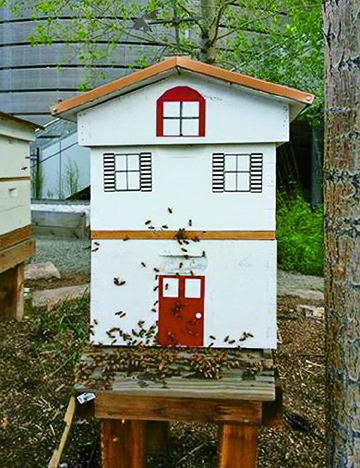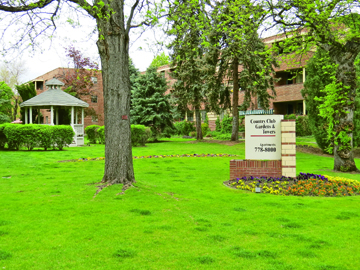
by Mark Smiley | Aug 29, 2014 | Travel
by Mark Smiley
The award-winning Bella Diva Dance is moving from Cherry Creek North to Glendale after four years at 3rd and Clayton. “It was great working with th e city of Glendale. Obtaining permits is easier in a smaller city. There was not a lot of red tape,” said Caitlin Brozna-Smith, owner and founder of Bella Diva Dance Studio. They have invested over $10,000 in building a brand new dance studio in the Glendale Center located at 4309 E. Mississippi Avenue.
e city of Glendale. Obtaining permits is easier in a smaller city. There was not a lot of red tape,” said Caitlin Brozna-Smith, owner and founder of Bella Diva Dance Studio. They have invested over $10,000 in building a brand new dance studio in the Glendale Center located at 4309 E. Mississippi Avenue.
They are situated in the same shopping center where longtime Glendale businesses, Bistro Boys Catering, The Bo okies, and Dr. Proctor’s Lounge are located. Brozna-Smith’s business partner Erin Anderson shares the space with her business, Communitas.
The two met four years ago while Anderson was taking one of Brozna-Smith’s classes at the Cherry Creek Athletic Club. Communitas focuses on creating a healing space which includes massage therapy and extensive body work.
The Bella Diva Dance Studio, founded in 2010, does not focus on the traditional ballet or tap dance. Bella Diva Dance offers a unique blend of modern Egyptian, American and Lebanese style dance technique. Particular emphasis is placed on body awareness, proper alignment and clean movement execution . They are a company dedicated to creating a community for belly dancers and samba dancers while elevating the art of both dance forms. They dance to share the joy and beauty of Middle Eastern and Brazilian dance through artistry, thoughtful innovation and quality classes.
. They are a company dedicated to creating a community for belly dancers and samba dancers while elevating the art of both dance forms. They dance to share the joy and beauty of Middle Eastern and Brazilian dance through artistry, thoughtful innovation and quality classes.
“Bella Diva Dance is a female empowering experience. Whether it’s attending one of the classes that push you physically to try new and exciting movements with your body, or attending a show, BDD always does a great job. I would highly recommend the classes or the shows to everyone I know,” said Valley resident Kara Thomas.
Class structure is based on a Western format of beginning with a thorough warmup including isolations and stretching, and then moving on to clear movement breakdowns, drilling the basics, hands-on corrections and integrating movements through combinations, choreography and improvisational exercises. Above all else, Bella Diva Dance celebrates the joy, femininity and individual expression inherent in Middle Eastern & Brazilian dance. Classes are taught on a monthly series-based curriculum, either being four or five classes per month. New series start the first Tuesday and Thursday of each month.
Members of the Bella Diva Dance Performing Company regularly perform at private parties, birthday and bachelorette parties, weddings, and festivals, throughout the Denver metro area. “We love to get out in the community and perform. We get an incredible response from spectators who love the uniqueness of the performances,” said Brozna-Smith.
In addition to being the owner and founder of Bella Diva Dance, Brozna-Smith is currently on faculty at the University of Denver as an Adjunct Professor of Dance and Stage Movement in the Theatre Department and Lamo nt School of Music. The Lamont School of Music is widely recognized as a premier university music performance school with a long-standing tradition of excellence.
nt School of Music. The Lamont School of Music is widely recognized as a premier university music performance school with a long-standing tradition of excellence.
This September, Bella Diva Dance will be pioneering a kids dance program offering Children’s World Dance for children ages 7-12, on Mondays, Tuesdays, and Thursdays from 4:30 p.m. to 5:30 p.m. Also in September, Bella Diva Dance is bringing in Afro-Caribe dance founder Eulanda Shead Osagiede from London to conduct an Afro-Caribe Unleashed Dance Fitness workshop during the World Dance Workshop Weekend. Afro-Caribe dance is typically joyful and free-spirited, and is often performed to Caribbean, Jamaican, highlife, jazz or soul music. The workshop will be held on Sunday, September 14 from 1 p.m. to 3 p.m.
For more information on any workshops or classes, visit Bella Diva Dance’s website at belladivadance.com or call them at 303-359-9414.

by Mark Smiley | Aug 29, 2014 | General Featured
Rules Hatched By City Council Also Allow Homegrown Sales In Kitchens, Yards Until Dusk
by Glen Richardson
Have you heard the buzz?
If not, step into your backyard and listen for the hum of bees. If you pay close attention you may also hear the sounds of chickens, ducks and goats! They’re some of the reverberations to expect as the Cherry Creek Valley rototills into full-fledged backyard farming. What’s more, anticipate that your street will also become one big Farmers’ Market as neighbors begin to sell their farm produce in their kitchens and from their front yards.
In July the Denver City Council approved a new law that allows residents to both raise and sell fresh produce they have grown themselves and “cottage foods” such as jams and honey they have made themselves in their home kitchens. Under the new law which took effect July 18, residents are required to purchase a permit but then will be able to sel l from home raw and uncut fresh fruit, vegetables and herbs that were grown by the seller either on site or in a community garden.
l from home raw and uncut fresh fruit, vegetables and herbs that were grown by the seller either on site or in a community garden.
City Farming Rules
Urban farmers will now be able to sell whole eggs produced by chickens or ducks kept by the seller at home or as un-refrigerated food products made on-site such as spices, teas, honey, jams and certain baked goods made themselves in their home kitchens. Under the law people can sell from inside or outside their home from 8 a.m. to dusk and can sell up to $5,000 worth of goods and produce a year.
The city requires that urban farmers apply for licenses to sell their food. The city charges a one-time fee of $20 for the license. Urban farmers setting up indoor or outdoor farmer markets are not required to provide parking spaces. No sales tax is required and the seller determines the sales prices. For neighborhood farmer markets only temporary, portable furniture is allowed — tables, stands and umbrellas — for outdoor sales and they must be taken inside between dusk and 8 a.m. daily. Signs for home sales must be flat, attached to a wall or window of the home, and cannot be more than 100 square inches in size. One sign is allowed per street front (one sign for most lots, two signs for a corner lot). No moving signs and no lit sign(s) are allowed.
Several city restaurants currently grow produce in gardens and farms they own and sell them in their local eateries. Now those plus other restaurants that don’t have gardens and farms will be able to buy vegetables, eggs, jams, and fruits being grown in the neighborhood by backyard farmers.
Hatching Big Ideas
As the backyard chicken craze spreads like wildfire it’s beginning to seem like the chicken coop is the new doghouse. Increasingly Valley fidos will have to share the yard with the ladies. But before getting in a flap with your pup be aware that sales of whole, fresh chicken eggs are limited to less than 250 dozen per month.
According to rules hatched by the city, egg cartons must include the origin of the eggs and the packing date. Unless the eggs were treated to prevent salmonella, the label must include safe handling instructions: To prevent illness from bacteria, keep eggs refrigerated, cook eggs until yolks are firm, and cook any foods containing eggs thoroughly. Cartons must be labeled: “These eggs do not come from a government-approved source.”
Eggs, produce and other products sold by urban farmers must have a label and be traceable to the seller. Labels must list the name of the product, the producer’s name address, telephone number and email. Items must also include where the food was prepared or grown, the date the food was produced and a complete list of ingredients. If a product was produced in a home kitchen that is not subject to state licensure or inspection and that may also list common food allergens such as tree nuts, peanuts, eggs, soy, wheat, milk, fish and crustacean shellfish, labels should read: This product is not intended for resale.
Who’s Digging In?
Who are these upstart urban farmers with enthusiasm for having dirt under their finger nails, bees and chickens in their backyard, and fresh food in their bellies? It’s locals like Brenna Brooks-Larson, a Valley elementary school teacher who helped launch Celebration Community Farm in the Virginia Village neighborhood on the corner of Iowa and Birch. She grew up in Denver and is now a board member of UrbiCulture Community Farms. Her love for farming began in Nicaragua as a Peace Corps volunteer where she managed three school gardens. Or gardening volunteers like Maggie Rice, the second woman in Colorado to become a Certified Working Chef. She is building a Permaculture Institute on 1.5 acres 10 minutes from downtown Denver.
Also among the back-to the-land group is James Bertini, a lawyer turned farmer whose backyard on Fourth Ave. and Kalamath has chickens, rabbits and a garden plot. His interest in farming began with his wife Irena’s dissatisfaction with the prevalence of processed foods. The pair own and operate Denver Urban Homesteading — a year-round farmers market on Santa Fe — selling locally grown produce and foodstuffs. A horde of backyard farmers can be found buying chickens, rabbits and other backyard critters at a livestock exchange sponsored by the couple each month.
Many like Jason Plotkin — Farm Manager at Lowry’s Ekar Farm & Community Garden — got into farming to help neighbors and society in general. The farm hosts 50 community garden plots within the diverse Lowry neighborhood. Ekar engages 1,000 community volunteers in growing 25,000 pounds of urban organic vegetables. The farm donated 85 percent of the vegetables grown — with a market value of $95,000 — to Jewish Family Service, Weinberg Food Pantry and other food relief agencies that feed 2,500 people a month during the harvest season.
Cultivating Change
The Valley’s backyard farming boom began more than 25 years ago when the nonprofit Denver Urban Gardens (DUG) began working with the community to build and support gardening. The organization currently organizes and manages well over 100 community gardens, including 35 at Valley schools. By 1993, DUG was coordinating 21 local gardens, and by 1997, 32 new gardens and DeLaney Community Farm were established. Within the past decade it has created multiple ongoing youth and community education programs designed to assist community involvement and long-term garden sustainability.
Another significant backyard farming venture is the community farm at Valley-based Denver Green School, run by Sprout City Farms. It is a one-acre organic farm located along East Virginia Ave. Produce from the farm is used for the school salad bar as well as in cooked meals for about seven out of the nine months during the school year. The farm is able to meet nearly all the produce needs for the school kitchen from August to October. Sprout Farms believes the future of urban agriculture requires a shift in thinking, eating and acting.
Even the city has gotten into the backyard-farming act with a plot on the grounds of the Colorado Convention Center. Known as Blue Bear Farm, the 5,000-square-foot farm is located on the sunny south side of the convention building. Beds bloom with crops of fresh fruits, vegetables and herbs that are used by Centerplate chefs at the Convention Center. Basil, beans, peppers and parsnips plus radishes and raspberries are among crops grown. The farm has two beehives providing fresh honey to convention attendees.

by Mark Smiley | Aug 29, 2014 | Main Articles
Construction Of Towers Into Historic Six-Acre Site Seen By Activists As Giving Area And Denver Another Black Eye
by Glen Richardson
Country Club Gardens — the historic 1940s five-building three-story apartment complex located in a six-acre landscaped garden environment adjacent to the Downing Street Parkway — is about to get hit with a pair of huge apartment houses as densification of the Cherry Creek and Country Club areas continues on unabated. The Broe Group is demolishing two existing garden apartments and replacing them with two overwhelming 30-story towers near the intersection of Downing St. and Ellsworth Ave.
The twin skyscrapers will be the tallest buildings outside of downtown Denver and will be equal in height to the One Tower Center on 17th Street, the 15th tallest building in Denver. By comparison, Plaza Tower One — one of the tallest towers in the Denver Tech Center — is only a 22-story building. The two towers will contain a total of 533 apart ment units and several floors of structured parking. The two buildings will be mirror images of one another and top out at 322 feet in height.
ment units and several floors of structured parking. The two buildings will be mirror images of one another and top out at 322 feet in height.
The two towers, along with the existing 22 story building at 1001 East Bayaud also constructed by Broe, will block the view of the mountains for much of the Cherry Creek area.
The latest plan is in response to a hostile historic designation effort undertaken in 2007. In response to those hearings Broe agreed to retain the three northern buildings at the Gardens in exchange for the right to build out the balance of the site. Area residents however are not pleased or content with the recent Landmark Planning Commission (LPC) decision to approve the two massive residential towers. They tell the Chronicle that the development-oriented Broe Group has been jabbing away at their neighborhood icon for 20 years and the proposed massive two-tower complex represents the k nockout punch.
nockout punch.
Residents Up In Arms
How will the twin skyscrapers impact the unique character of this celebrated neighborhood? “It will be devastating to the historic significance, charm and personality of Country Club Gardens,” said Karen Mansfield. “No one likes to have dark circles under their eyes but we’re like the kid that got hit with a shiner and we are fully expecting to have two black eyes soon.” The tower design, they say, tries to put the historic area on a pedestal with a snooty, rock star look. “We’ve been hit with a catchy hook that’s simply not a good look,” said Mansfield.
Kristian Jeichler noted to the Chronicle, “This is going to drastically change the Denver skyline and life in the Cherry Creek area.” The concern is that the two buildings will indelibly alter many Cherry Creek neighborhoods for better or for worse, depending on the perspective. Residents make the case that the towers take the trajectory of the historic area in a direction that falls short. “They will forever change the Valley skyline while damaging the unique layout of the buildings, internal courtyards and connecting open space within the Gardens,” said Jonathan Pierson.
Along with concerns about the mass and scale of the towers, the Landmark Planning Commission has also expressed unease about the project’s impact on the historic courtyards and landscaping. “Preservation and compatible development of the landscape and courtyard are critical to retaining the character of Country Club Gardens,” according to the LPC report. The commission is waiting on a pending arborist report. The LPC is also providing a design review over the demolition and construction activity directly related to the project outside of the boundaries of the Country Club Gardens Historic District. This includes improvements off of Bayaud St. adjacent to the historic landmark Norman site.
Broe’s Reputation
Over the years, Developer Pat Broe has garnered a reputation as a ruthless tough negotiator who is personally despised by many people but admired for his ability to make money. Don Elliman, the former director of the Colorado Office of Economic Development and International Trade, described Broe as “a complex guy who rubs some people the wrong way…” While Tom Clark, when he was executive vice president of the Metro Denver Economic Development Corp., declared, “We counsel our clients that they will not face a more challenging negotiation than they will with the Broe company.”
When asked whether he would even do business with Broe, Elliman said he would, “But I’d have my hand on my wallet and I’d have a damn good lawyer with me.”
Excavation Impact
The fight isn’t entirely over yet, Cherry Creek Garden activists say, noting that the Landmark Planning Commission’s recommendation for approval comes with conditions. The LPC report says the mass and scale must be consistent with the development agreement and the axial views and open space preserved and reinforced. Furthermore, approval is conditional on new plantings respecting and reinforcing historic patterns. Additionally, parking is required to be screened on all sides and integrated into massing of the new structures. Few believe that any of those requirements has the possibility of derailing the project.
The Broe Group will begin work this fall to raze the parking garage and portions of two of the apartment buildings where the twin towers are to be built. Construction of the towers themselves is set to begin in early 2015, with completion in late 2016.
When questioned about the impact of construction on people living in the Cherry Creek Gardens area, a spokesman for Broe told neighborhood groups that during peak excavation a dump truck would be coming or going from the project site approximately every 10 minutes. The spokesperson added that construction staging and other activities would be performed away from the site to limit disturbance. Also workers are to be bused to the area to reduce the congestion of trucks and other vehicles within the immediate area.
What Of Historic Significance Is Being Destroyed?
Constructed in 1940, Country Club Gardens was an excellent example of the International Style exemplified by the overall horizontality of the composition. Fisher, Fisher and Hubbell Architects — a leading Denver firm at the time — designed the buildings. The firm’s principals were Arthur Addison Fisher (1878-1965), his nephew Alan Berney Fisher (1905-1978), and Edward L. Hubbell. Nicholas G. Petry (1883-1950) was responsible for construction. He came to Denver in 1921 after building the Frontier Hotel in Cheyenne. Petry built many Valley buildings including Sherman Tower, the University of Denver apartments, and several Fitzsimons Hospital and Buckley Field buildings. With both residents and passersby in mind landscape architect M. Walter Pesman planned the landscaping with meticulous detail.

by Mark Smiley | Aug 29, 2014 | Main Articles
Complaints Flood City
The low slung masonry building at the corner of East Virginia Avenue and South Colorado Boulevard has been a Glendale landmark for over a half century, originally housing Club Monaco, and later such iconic businesses as Andy’s Smorgasbord, the Bavarian Inn, and, since 1982, Shotgun Willie’s adult nightclub. Today, however, the abandoned and graffitied building is an eyesore which has drawn complaints from businesses up and down Colorado Boulevard as well as residents of Glendale and Denver.
In November 2013, Shotgun Willie’s moved out of the building to the adjoining lot on which it had constructed its own new building. The City of Glendale condemned a portion of the land to provide a right turn lane due to the increased traffic generated by the adjoining Super Target. The old Shotgun Willie’s building and lot is owned by the Anthony Marino Family Trust.
After complaints at City Council meetings, the City threatened the Family Trust that it would declare the property a nuisance and tear down the building itself and bill the Family Trust its “applicable share.”
On August 15, however, Glendale and the Family Trust entered into a formal agreement whereby the City of Glendale granted a temporary construction easement for two months and will pay $10,000 toward the demolition of the building by Dave Stefanich, Inc. d/b/a All Demolition Excavating Company, a contractor of the Family Trust.
While the agreement does not mandate the demolition by any certain date, the two-month temporary easement would appear to require the destruction of the building by no later than October 15, 2014.
Marcus Rice, who went to a Glendale City Council meeting to complain about the abandoned building stated, “It is good news that building will be coming down in the near future. Glendale is turning into such a great place but the property was hurting the image of Glendale as well as that of Colorado Boulevard.”
Debbie Mathews, the majority owner of Shotgun Willie’s, noted, “We loved that old building while we were a tenant for decades but nobody is happier to find out that the City and the Anthony Marino Family Trust have come to an agreement to clean up the corner which our new building is directly behind. Sounds like a win-win for everyone involved.”

by Valley Gadfly | Aug 29, 2014 | Valley Gadfly
Hot, chic, typical, crazy, outrageous, amazing, innovative or tacky, fads and trends come and go and are the bookmarks of a certain time. As the hot weather slowly comes to a halt we’re feeling a bit contemplative about where to go and what to do. But autumn will fly by in a flash so take advantage of the crisp weather and fall foliage.
A fad, like food trucks, is a practice or interest that we follow for a period of time with exaggerated zeal. Strange as it may be, fads and trends reshape what we do.
So in the name of turning over a fall leaf, here are our choices for shopping, dining and entertainment to keep you as trendy as the hottest, latest outrageous fad:
3 Beautiful flowers never go out of style and the Dahlia is among the prettiest. See large arrangements on display at the Dahlia Society Show at Paulino Gardens, Sept. 6-7, 10 a.m.-5 p.m. Information: 303-429-8062.
3 For fab free fall fun take in the Cherry Creek East’s Jazz Concert in Pulaski Park Sept. 8, 6:30 p.m. Information: www.cherrycreekeast.org.
3 Zoom in on American West color photography at opening reception at Robert Anderson Gallery, Sept. 12, 5-8 p.m. Information: 303-871-0800.
3 To be safe attend the Public Safety Expo at South High’s parking lot with food and live music Sept. 13, 10 a.m.-2 p.m. Information: 720-210-4056.
3 Make a good night’s sleep more than a passing fad by trying better mattresses for a better price from the recently opened SleepNation in Century 21 Plaza on South Colorado Blvd. Information: 303-954-9435.
3 For fabulous weekend football brunch specials plus happy hour all day hang out at the Monaco Inn Restaurant. Information: 303-320-1104.
3 Hop, skip and jump with the kids as they crawl, trot and run the kid course at the Children’s Museum Sept. 21, 9 a.m. Information: 303-561-0104.
3 Start a trend by watching Latin, Mexican, & European films showing at CineLatino in the Sie FilmCenter Sept. 25-26. Information: 720-381-0813.
3 This month’s hottest, hippest stage show is Grace playing at the John Hand Theatre, Sept. 4-27. This is a darkly funny, often hilarious, deadly serious and provocative play. Basically the story is an exploration of human assumption about how God, goodness, faith and causality operate. Performances are Thursday through Sunday plus a show on Monday, Sept. 27th. Information: 303-999-9143.
Whether we want to admit it or not we latch onto fads in fashion, pop culture, technology, and yes, even fads in foods. Every month it seems there’s a new “it” something. Smartphones, today’s mega technology trend, will likely seem ridiculous to people in 15 years. We’ll probably just have chips on wristwatches or in our heads.
Every eatery serves the latest craze — desserts with bacon, catfish croquettes, kiwi cocktails. But soon the fad fades, and the flavor of the week will settle into obscurity.
For fall fun get lost in a corn maze, go for a hayride or take a hot-air balloon ride. How about renting a cabin in the mountains or tailgating at football games? The latest wacky fad is banning automobile parking on city streets. You see cars are just a passing fad. Then again I’m going to start writing letters again once the email fad passes.
— Glen Richardson

 e city of Glendale. Obtaining permits is easier in a smaller city. There was not a lot of red tape,” said Caitlin Brozna-Smith, owner and founder of Bella Diva Dance Studio. They have invested over $10,000 in building a brand new dance studio in the Glendale Center located at 4309 E. Mississippi Avenue.
e city of Glendale. Obtaining permits is easier in a smaller city. There was not a lot of red tape,” said Caitlin Brozna-Smith, owner and founder of Bella Diva Dance Studio. They have invested over $10,000 in building a brand new dance studio in the Glendale Center located at 4309 E. Mississippi Avenue. . They are a company dedicated to creating a community for belly dancers and samba dancers while elevating the art of both dance forms. They dance to share the joy and beauty of Middle Eastern and Brazilian dance through artistry, thoughtful innovation and quality classes.
. They are a company dedicated to creating a community for belly dancers and samba dancers while elevating the art of both dance forms. They dance to share the joy and beauty of Middle Eastern and Brazilian dance through artistry, thoughtful innovation and quality classes. nt School of Music. The Lamont School of Music is widely recognized as a premier university music performance school with a long-standing tradition of excellence.
nt School of Music. The Lamont School of Music is widely recognized as a premier university music performance school with a long-standing tradition of excellence.

 l from home raw and uncut fresh fruit, vegetables and herbs that were grown by the seller either on site or in a community garden.
l from home raw and uncut fresh fruit, vegetables and herbs that were grown by the seller either on site or in a community garden.

 nockout punch.
nockout punch.
